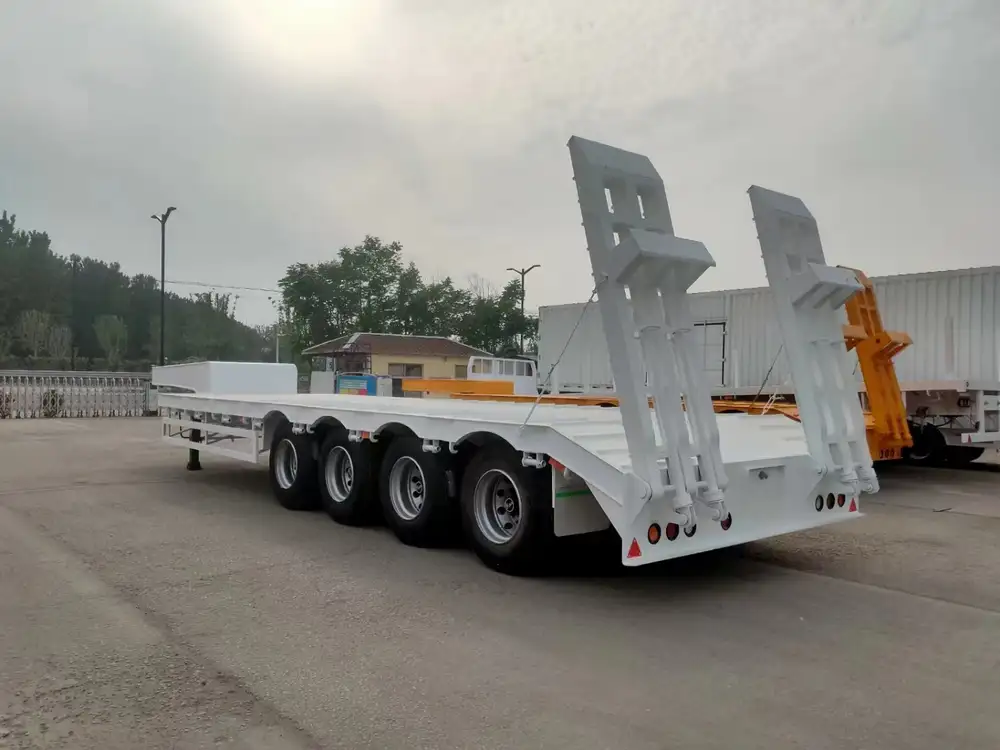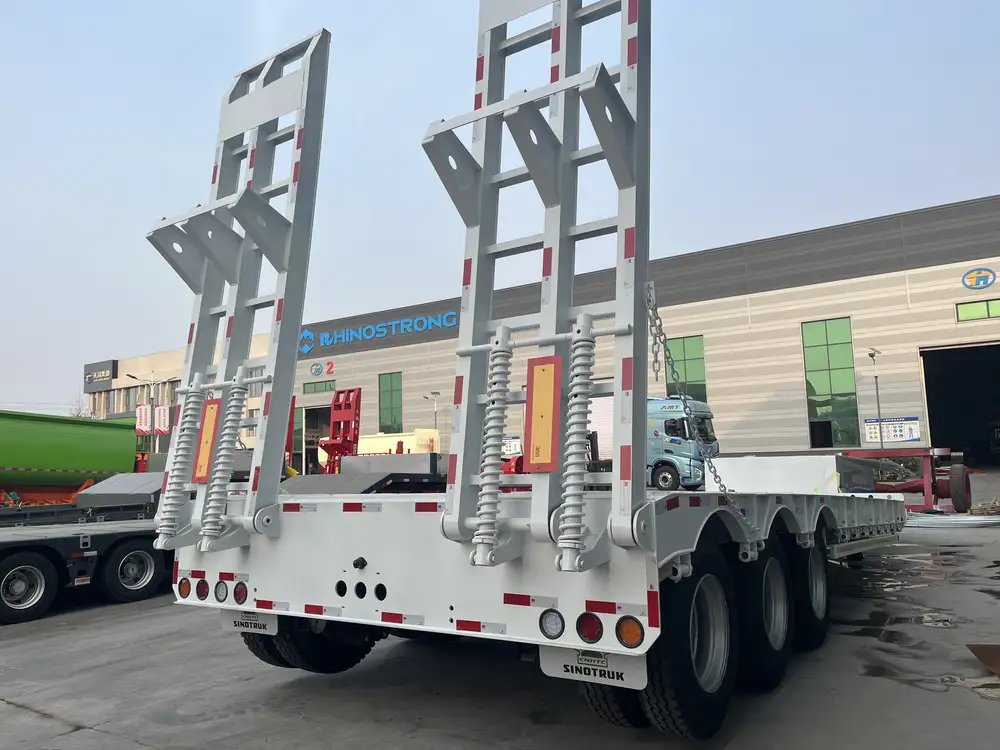What is the Bumper on the Back of a Semi-Trailer?
A semi-trailer’s bumper, often referred to as the rear underride guard, is a crucial safety feature designed to minimize the risk of accidents involving smaller vehicles colliding with the rear of the trailer. Typically composed of robust materials such as steel, it serves as a protective barrier, absorbing impact and preventing cars from sliding underneath the trailer. This aspect of semi-trailer design is not merely for structural integrity; it’s a pivotal element in ensuring the safety of all road users.
Types of Bumpers
Bumpers can vary significantly depending on the manufacturer, the intended use of the trailer, and compliance with federal and state regulations. Here are the most common types of bumpers found on semi-trailers:
| Type of Bumper | Description | Suitability |
|---|---|---|
| Standard Steel Bumper | A heavy-duty option designed to withstand significant force, typically rectangular and mounted low. | General freight transportation |
| Reinforced Bumper | A standard bumper augmented with additional steel or composite materials for increased strength. | Heavy haul and specialized loads |
| Aluminum Bumper | Lightweight and rust-resistant, offering a balance of strength and weight savings. | Long-distance hauling |
| Composite Bumper | Made from advanced materials, these bumpers provide durability and weight efficiency. | Custom trailer applications |
| Tapered Bumper | Features a design that encourages safe impact dispersal, minimizing damage. | Urban delivery vehicles |

Importance of Bumper Design and Regulation
Safety Standards and Compliance
In many jurisdictions, bumpers on semi-trailers are required to comply with Federal Motor Vehicle Safety Standards (FMVSS). These regulations outline the minimum performance criteria a bumper must meet to be classified as safe. For instance, under FMVSS 223, the bumper’s design and installation must mitigate the risk of underride accidents, which can lead to severe injuries or fatalities.
How Bumper Design Influences Safety
The shape and material of a bumper heavily influence its effectiveness. A well-designed bumper must not only absorb impact but also maintain its structural integrity throughout its lifecycle. Here are critical aspects that contribute to bumper efficacy:
- Material Strength: High-strength materials ensure the bumper can withstand heavy impacts. Steel is a popular choice due to its durability, while aluminum offers a lighter alternative without sacrificing strength.
- Height and Position: The bumper must be positioned correctly to prevent smaller vehicles from slipping underneath. The optimal height in relation to typical passenger vehicles is a critical consideration in bumper design.
- Energy Absorption: The bumper should be designed to absorb and dissipate energy upon impact, reducing the force transmitted to the trailer and the vehicle involved in the collision.

Common Questions About Semi-Trailer Bumpers
What is Underride?
Underride occurs when a smaller vehicle strikes the rear end of a trailer and slides underneath it. This type of accident can result in catastrophic injuries, largely due to the vulnerable nature of passenger vehicle occupants. The design of the bumper plays a substantial role in preventing such incidents, with regulations in place mandating the height, width, and strength of bumpers to minimize the risk of underride.
How is the Rear Bumper Maintained?
Regular maintenance of the bumper is critical to ensure its effectiveness. Common maintenance steps include:
- Visual Inspections: Regularly assess the bumper for any signs of wear, rust, or structural failure.
- Repairs: Promptly repair or replace damaged bumpers to maintain safety standards.
- Applying Protective Coatings: Use anti-corrosive coatings to enhance the longevity of the bumper, particularly for models exposed to harsh environmental conditions.

What Are the Legal Implications of Non-Compliance?
Operating a semi-trailer without a compliant bumper can have serious legal repercussions. In the event of an accident, lacking a properly designed bumper can lead to liability issues, potential lawsuits, and significant financial penalties for the operator. Thus, ensuring that a semi-trailer includes a legally compliant bumper isn’t merely about safety—it’s also about adhering to regulatory standards.
Benefits of a High-Quality Semi-Trailer Bumper
Investing in a high-quality bumper for a semi-trailer reaps numerous benefits that extend beyond mere compliance with safety regulations. Here are several advantages to consider:
Enhanced Safety for All Road Users
The primary function of a semi-trailer bumper is to ensure the safety of all road users. By reducing the risk of underride collisions, a well-designed bumper saves lives and minimizes injuries. This aspect not only protects the driver of the tractor unit but also safeguards the occupants of smaller vehicles.

Cost-Effectiveness Over Time
While high-quality bumpers may require a more considerable initial investment, they often yield long-term savings through reduced maintenance costs and extended service life. Durable materials and thoughtful designs reduce the frequency of replacements and repairs, translating to financial benefits over the trailer’s operational lifespan.
Improved Resale Value
Maintainable and compliant bumpers contribute positively to a semi-trailer’s resale value. Buyers are increasingly aware of safety regulations and the implications of bumper quality. A semi-trailer with a high-quality, well-maintained bumper is more likely to attract buyers, ensuring better resale prospects.
Increased Operational Efficiency
Incorporating a bumper that meets safety standards reduces the potential for accidents, leading to fewer disruptions in haul schedules. Improved safety translates to more reliable transport operations, which can enhance overall operational efficiency. This consideration is vital for companies focused on optimizing logistics and supply chain performance.

Conclusion: The Critical Role of Bumpers in Semi-Trailer Safety
In summary, the bumper on the back of a semi-trailer serves an indispensable role in ensuring roadway safety. Its design, compliance with regulations, and ongoing maintenance are crucial factors that contribute to its effectiveness. As we have explored, a well-constructed bumper not only protects the trailer and driver but also plays an essential part in safeguarding other road users against potentially disastrous underride accidents.
Investing in high-quality bumpers proves beneficial from both a safety and financial perspective, making them an indispensable component of modern semi-trailer design. By understanding the nuances surrounding this vital feature, operators can make informed decisions that prioritize both compliance and safety.
Take Action: Prioritize Your Safety and Compliance
If you are a semi-trailer manufacturer or operator, consider reviewing your bumper design and maintenance protocols. Investing in robust, compliant bumpers can significantly reduce the risk of accidents, protect lives, and enhance your operation’s overall efficiency. Remember, safety starts with the proper components on your vehicles—make sure your semi-trailers are equipped to perform their best on the road.
In crafting this comprehensive exploration of semi-trailer bumpers, we aspire to not only inform but to encourage proactive measures that will enhance safety standards and operational efficiency within the industry. It’s more than a regulatory necessity; it’s a commitment to making our roads safer for everyone.



